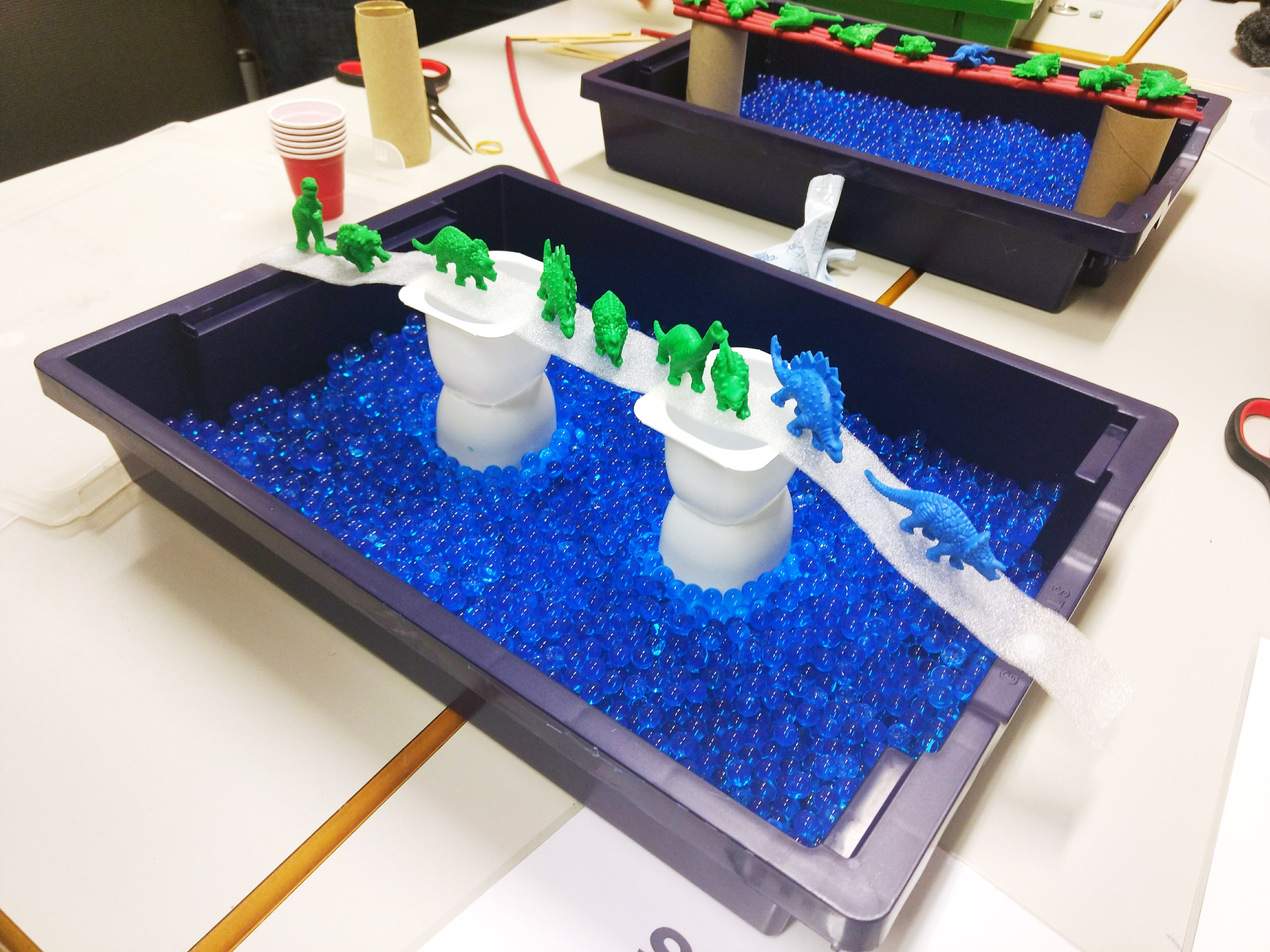Dinosaurs love bridges
This activity was created as part of a Gratnells What’s In My Tray CPD workshop for primary science teachers and teaching assistants to support practical work and delivery of the curriculum. It can be carried out as a stand-alone activity for students or combined with other activities from the session to form a STEM carousel.
The Dinosaur Counters used in this activity are available from Edx Education.
You will need (per team of 4):
- Shallow Gratnells tray (F1) with office insert and lid
- 5 x Thick art straws
- 4 x Small cardboard tubes
- 10 x Lollypop or craft sticks
- 1 x Washi or coloured tape
- 6 x Plastic shot glasses
- 4 x Yoghurt pots
- 5 x Elastic bands
- 2 x Strip of bubble wrap
- 2 x Strip of packing material
- 1 x Blue Tac pack
For the table:
- Full set of Dinosaur Counters from Edx Education in a shallow Gratnells (F1) tray with six-section insert and lid.
- 2 x Shallow blue Gratnells trays (F1) half filled with blue water beads with lids.
Tip: if you are running this activity as a team challenge, use different coloured elastic bands, art straws and tape for each team and coordinate the colour of the equipment to their trays. Bubble wrap and packing material could be substituted for colour coordinated card strips. However, just use whatever materials you have available and even better if they are recycled.
Preparation: Make up the water beads in advance of the session, split them between the two blue trays and put the lids on. Place all construction materials into the shallow tray with office insert and put the lid on.
This activity also works as an individual challenge, just increase the amount of time allocated to complete it and reduce the amount of equipment. The majority of the equipment is reusable after it dries out and is pulled apart. I you are running this activity as part of a team carousel, it is recommended to have a set for each team to make swap over between groups easier.
What to do:
- Dinosaurs migrate too! Help the dinosaurs escape the long dark winter and get to land with more food and water by building them two bridges over the river (water bead trays).
- The two bridges must be of differing designs. The bridges must span the longest length of the trays.
- Build one bridge in each tray (work in pairs).
- If any dinosaurs fall in the river they will be swept away. You cannot pick them up out of the water once they have fallen.
- When the allocated time for the activity has ended, note down how many dinosaurs are left standing on your bridges and how many are in the river.
- Take photographs of your work, capturing both bridges.
- The winning team will be the one with the most dinosaurs on bridges when the time is up. If there is a tie break, then the team with the smallest number of dinosaurs in the river wins.
Tidy up time:
- Take the bridges apart, put the construction materials back in their original tray and put it to one side.
- Put the dinosaurs back in their tray.
- Leave the water bead and dinosaur trays on the table for use by the next team.
- Put out a fresh consumables tray for the next team.
What is happening?
People have been designing and building bridges for hundreds of years. Bridges need to be able to support weight so that people and loads may cross them. Force is exerted on bridges from above (vertically) and sideways (horizontally). The relationship between the forces acting on the bridge are very important, too much tension (pulling force) or too much weight or applied force (push) will cause a bridge to sag or buckle.
The most important shape in bridge engineering is the triangle, because of its strength. You could have a go at testing this too.
There are different types of bridge, which rely on different engineering principles for their success. You may like to look up truss, arch, cable-stayed and suspension bridges and have a go at building different types. They all deal with forces and weight in different ways.
Other things to try…
- Modify the challenge to make a bridge for a specific number of dinosaurs (e.g. 10-15) using the least amount of construction materials possible (efficiency challenge).
- Make an even longer bridge! Collect a range of recycled materials to add to those you have already. Use a Gratnells A3 tray half filled with water beads and supersize your challenge!
- Share your photographs with the rest of your class, discuss the different bridge designs, were some more successful then others?
- Research different bridge designs and the engineers who designed and built them, learn as much as you can about what makes for the best bridge design. Repeat the challenge using what you know and construct even better bridges.
- Share the photographs of your bridges on social media using #WhatsInMyTray
- Try our other STEM challenges, we have sailboats, rockets, cargo boats and buggies just for starters!
Health & Safety
As with all Gratnells Learning Rooms What’s In My Tray Activities, you should carry out your own risk assessment prior to undertaking any of the activities or demonstrations.


